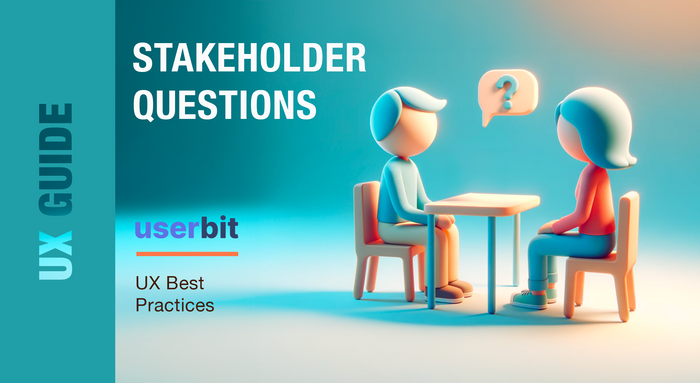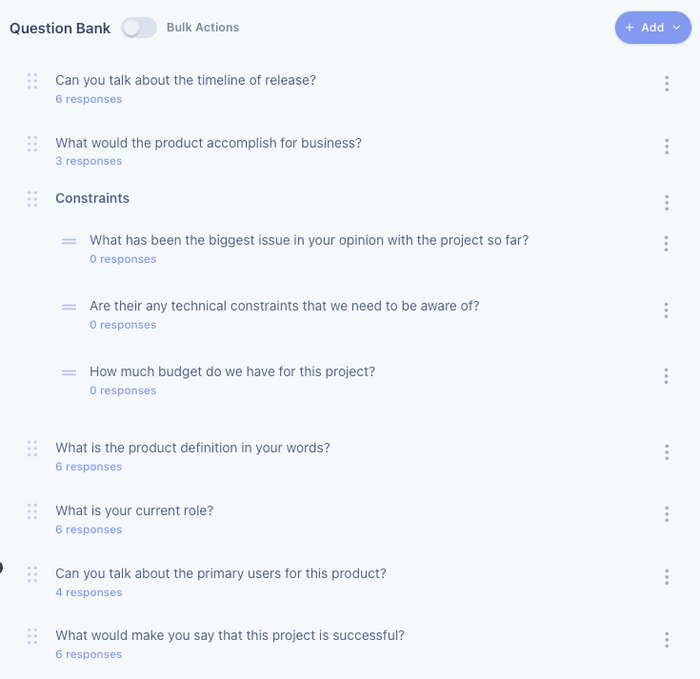
12 Excellent Stakeholder Interview Questions
When we talk about stakeholders, we're talking about the “internal VIPs” — the executives, designers, sales reps, or clients if you're agency-side.
They're the ones with the power to shape, shake, and sometimes even break your project (but let's not go there today 😜).
Stakeholders bring clarity to your project goals, reveal hidden limitations, and, let's not forget, they build that crucial bridge of trust and buy-in.
That’s why conducting interviews with your stakeholder(s) can help you see the full picture of where you’re heading and what it’ll look like.
Today, let’s talk about 12 questions that are ideal to ask during stakeholder interviews. Here we go!
1. "Can you describe the vision for this project?"
Understanding the stakeholder's vision provides a guiding light for the project as it aligns every team member's efforts and ensures that the project contributes meaningfully to the broader organizational goals.
A clear vision statement that your stakeholder can provide to you can help you all make strategic decisions and keep the project on track.
2. "What are your most crucial goals and objectives for this project?"
This question uncovers the primary targets the stakeholder aims to achieve.
Knowing these goals helps in prioritizing tasks, allocating resources efficiently, and setting clear milestones.
Having a good idea what your stakeholder cares about the most also aids in measuring project progress against these defined objectives.
3. "In your perspective, what does success look like for this project?"
Different stakeholders may have varying definitions of success, so asking this question helps in creating a shared understanding of what a successful outcome entails.
It's key for setting realistic expectations and establishing a common ground for evaluating the project's success post-completion.
4. "Are there any specific metrics or outcomes you're aiming for?"
Metrics and outcomes provide concrete benchmarks for assessing the project's performance.
Understanding these allows the team to focus on delivering results that matter and provides a quantifiable way to track progress and success.
5. "What are the biggest challenges or obstacles you foresee?"
Identifying potential challenges early on helps in proactive risk management.
It allows the team to develop contingency plans, allocate resources for risk mitigation, and adjust strategies as needed to navigate these challenges effectively.
6. "How should the team prepare to tackle these potential hurdles?"
This question not only identifies challenges but also seeks actionable insights from the stakeholder on how to overcome them.
It leverages the stakeholder’s experience and knowledge, which can be invaluable in formulating effective strategies to address these hurdles.
7. "Who do you see as the primary users of our product/service?"
Identifying the primary users is crucial for ensuring the project outputs are user-centric and helps in tailoring the design, functionality, and overall user experience to meet the specific needs and preferences of these users.
8. "What are the key needs and pain points of these users/customers?"
Understanding user needs and pain points enables the team to design solutions that are truly impactful.
It ensures that the project delivers value to its users, addressing their challenges and enhancing their experience with the product or service.
9. "How does this project align with our broader business strategy?"
This “big picture” type question ensures that the project:
- Contributes strategically to the overall goals of the organization
- Highlights the project's relevance and importance within the larger business context
- Ensuring that resources are being invested in initiatives that drive the company forward
10. "Are there any business constraints or limitations we should be aware of?"
Awareness of constraints such as budget, timeline, or resources helps in realistic and effective planning.
It sets boundaries within which the project team must operate, encouraging creative solutions while acknowledging practical limitations.
11. "What is your role and level of involvement in this project?"
Clarifying the stakeholder's role and involvement helps in understanding their perspective, influence, and expectations.
Asking this question defines the lines of communication and decision-making authority, which is vital for effective project management and stakeholder engagement.
12. "How will decisions be made and communicated?"
This question is key to understanding the project's governance structure as it clarifies how decisions will be made, who will be involved in the decision-making process, and how those decisions will be communicated to the team.
Knowing this helps in creating a smooth decision-making process, avoiding misunderstandings, and ensuring that all team members are informed and aligned.
Tip: You can organize stakeholder interviews and questions on UserBit for easy cross-case analysis.
To wrap up
Remember, every stakeholder conversation is a step closer to a project that not only meets but exceeds expectations.
To further enhance this process, consider leveraging UserBit.
Our platform offers a comprehensive stakeholder and participant management tool, enabling you to organize and streamline your interviews efficiently and keep track of all your stakeholder interactions in one convenient place.
Our Client portal also acts as a knowledge base that lets stakeholders stay updated with the work so it ensures continuous alignment and transparency throughout the project lifecycle.
Happy interviewing!
Explore more about how UserBit can streamline your stakeholder interviews and project management at userbit.com.


